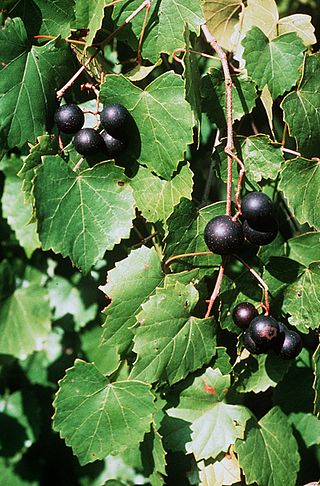Related Research Articles

A grape is a fruit, botanically a berry, of the deciduous woody vines of the flowering plant genus Vitis. Grapes are a non-climacteric type of fruit, generally occurring in clusters.

Gluten is a structural protein naturally found in certain cereal grains. Although "gluten" often only refers to wheat proteins, in medical literature it refers to the combination of prolamin and glutelin proteins naturally occurring in all grains that have been proven capable of triggering celiac disease. These include any species of wheat, barley, rye and some oat cultivars, as well as any cross hybrids of these grains. Gluten makes up 75–85% of the total protein in bread wheat.

Polyphenols are a large family of naturally occurring phenols. They are abundant in plants and structurally diverse. Polyphenols include flavonoids, tannic acid, and ellagitannin, some of which have been used historically as dyes and for tanning garments.

Vitis rotundifolia, or muscadine, is a grapevine species native to the southeastern and south-central United States. The growth range extends from Florida to New Jersey coast, and west to eastern Texas and Oklahoma. It has been extensively cultivated since the 16th century. The plants are well-adapted to their native warm and humid climate; they need fewer chilling hours than better known varieties, and thrive in summer heat.

Gliadin is a class of proteins present in wheat and several other cereals within the grass genus Triticum. Gliadins, which are a component of gluten, are essential for giving bread the ability to rise properly during baking. Gliadins and glutenins are the two main components of the gluten fraction of the wheat seed. This gluten is found in products such as wheat flour. Gluten is split about evenly between the gliadins and glutenins, although there are variations found in different sources.
Proanthocyanidins are a class of polyphenols found in many plants, such as cranberry, blueberry, and grape seeds. Chemically, they are oligomeric flavonoids. Many are oligomers of catechin and epicatechin and their gallic acid esters. More complex polyphenols, having the same polymeric building block, form the group of tannins.

Anthocyanins, also called anthocyans, are water-soluble vacuolar pigments that, depending on their pH, may appear red, purple, blue, or black. In 1835, the German pharmacist Ludwig Clamor Marquart gave the name Anthokyan to a chemical compound that gives flowers a blue color for the first time in his treatise "Die Farben der Blüthen". Food plants rich in anthocyanins include the blueberry, raspberry, black rice, and black soybean, among many others that are red, blue, purple, or black. Some of the colors of autumn leaves are derived from anthocyanins.

The phenolic content in wine refers to the phenolic compounds—natural phenol and polyphenols—in wine, which include a large group of several hundred chemical compounds that affect the taste, color and mouthfeel of wine. These compounds include phenolic acids, stilbenoids, flavonols, dihydroflavonols, anthocyanins, flavanol monomers (catechins) and flavanol polymers (proanthocyanidins). This large group of natural phenols can be broadly separated into two categories, flavonoids and non-flavonoids. Flavonoids include the anthocyanins and tannins which contribute to the color and mouthfeel of the wine. The non-flavonoids include the stilbenoids such as resveratrol and phenolic acids such as benzoic, caffeic and cinnamic acids.

The color of wine is one of the most easily recognizable characteristics of wines. Color is also an element in wine tasting since heavy wines generally have a deeper color. The accessory traditionally used to judge the wine color was the tastevin, a shallow cup allowing one to see the color of the liquid in the dim light of a cellar. The color is an element in the classification of wines.

Castalagin is an ellagitannin, a type of hydrolyzable tannin, found in oak and chestnut wood and in the stem barks of Anogeissus leiocarpus and Terminalia avicennoides.

Grandinin is an ellagitannin. It can be found in Melaleuca quinquenervia leaves and in oaks species like the North American white oak and European red oak. It shows antioxydant activity. It is an astringent compound. It is also found in wine, red or white, aged in oak barrels.

Syringetin is an O-methylated flavonol, a type of flavonoid. It is found in red grape, in Lysimachia congestiflora and in Vaccinium uliginosum. It is one of the phenolic compounds present in wine.

Laricitrin is an O-methylated flavonol, a type of flavonoid. It is found in red grape and in Vaccinium uliginosum. It is one of the phenolic compounds present in wine.

Condensed tannins are polymers formed by the condensation of flavans. They do not contain sugar residues.

The grape reaction product is a phenolic compound explaining the disappearance of caftaric acid from grape must during processing. It is also found in aged red wines. Its enzymatic production by polyphenol oxidase is important in limiting the browning of musts, especially in white wine production. The product can be recreated in model solutions.

Wine is a complex mixture of chemical compounds in a hydro-alcoholic solution with a pH around 4. The chemistry of wine and its resultant quality depend on achieving a balance between three aspects of the berries used to make the wine: their sugar content, acidity and the presence of secondary compounds. Vines store sugar in grapes through photosynthesis, and acids break down as grapes ripen. Secondary compounds are also stored in the course of the season. Anthocyanins give grapes a red color and protection against ultraviolet light. Tannins add bitterness and astringency which acts to defend vines against pests and grazing animals.
Food physical chemistry is considered to be a branch of Food chemistry concerned with the study of both physical and chemical interactions in foods in terms of physical and chemical principles applied to food systems, as well as the applications of physical/chemical techniques and instrumentation for the study of foods. This field encompasses the "physiochemical principles of the reactions and conversions that occur during the manufacture, handling, and storage of foods."
Pathogenesis-related (PR) proteins are proteins produced in plants in the event of a pathogen attack. They are induced as part of systemic acquired resistance. Infections activate genes that produce PR proteins. Some of these proteins are antimicrobial, attacking molecules in the cell wall of a bacterium or fungus. Others may function as signals that spread “news” of the infection to nearby cells. Infections also stimulate the cross-linking of molecules in the cell wall and the deposition of lignin, responses that set up a local barricade that slows spread of the pathogen to other parts of the plant.

δ-Viniferin is a resveratrol dehydrodimer. It is an isomer of epsilon-viniferin. It can be isolated from stressed grapevine leaves. It is also found in plant cell cultures and wine. It can also be found in Rheum maximowiczii.

Callistephin is an anthocyanin. It is the 3-O-glucoside of pelargonidin.
References
- ↑ Pocock, K. F.; Hayasaka, Y.; McCarthy, M. G.; Waters, E. J. (2000). "Thaumatin-like Proteins and Chitinases, the Haze-Forming Proteins of Wine, Accumulate during Ripening of Grape (Vitisvinifera) Berries and Drought Stress Does Not Affect the Final Levels per Berry at Maturity". Journal of Agricultural and Food Chemistry. 48 (5): 1637–1643. doi:10.1021/jf9905626. PMID 10820071.
- ↑ Marangon, M.; Van Sluyter, S. C.; Neilson, K. A.; Chan, C.; Haynes, P. A.; Waters, E. J.; Falconer, R. J. (2011). "Roles of Grape Thaumatin-like Protein and Chitinase in White Wine Haze Formation". Journal of Agricultural and Food Chemistry. 59 (2): 733–740. doi:10.1021/jf1038234. PMID 21189017.
- ↑ Siebert, K. J. (1999). "Effects of Protein−Polyphenol Interactions on Beverage Haze, Stabilization, and Analysis". Journal of Agricultural and Food Chemistry. 47 (2): 353–362. doi:10.1021/jf980703o. PMID 10563900.
- ↑ Waters, E. J.; Shirley, N. J.; Williams, P. J. (1996). "Nuisance Proteins of Wine Are Grape Pathogenesis-Related Proteins". Journal of Agricultural and Food Chemistry. 44: 3–5. doi:10.1021/jf9505584.
- ↑ Kwon, S. W. (2004). "Profiling of Soluble Proteins in Wine by Nano-High-Performance Liquid Chromatography/Tandem Mass Spectrometry". Journal of Agricultural and Food Chemistry. 52 (24): 7258–7263. doi:10.1021/jf048940g. PMID 15563204.
- ↑ Hsu, Juinn-Chin; Heatherbell, David A. (1987). "Heat-Unstable Proteins in Wine. I. Characterization and Removal by Bentonite Fining and Heat Treatment". American Journal of Enology and Viticulture. 38 (1): 11–16. doi: 10.5344/ajev.1987.38.1.11 . S2CID 12943855.
- ↑ Marchal, R.; Marchal-Delahaut, L.; Lallement, A.; Jeandet, P. (2002). "Wheat Gluten Used as a Clarifying Agent of Red Wines". Journal of Agricultural and Food Chemistry. 50 (1): 177–184. doi:10.1021/jf0105539. PMID 11754564.